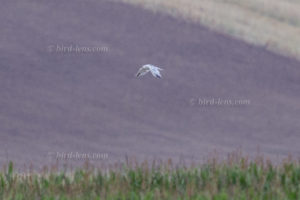 At least since Saturday, July 19, 2014, a plateau east of Marburg, the Schroecker Feld, is home to a male Pallid Harrier (Circus macrourus) on. The Schroecker Feld near Marburg is roughly 100km distant from downtown Frankfurt/ Main. This Pallid Harrier male has very pale grey upperparts and is white below. In flight, the distinctive black wing tips can be seen. Young male Pallid Harrier look not so bright white, in the earliest stages, they have coloration similar to the female. This individual seemed very light, almost white, but had – as is recognizable in the photo of the flying male Pallid Harrier – some darker wash on the upper wings. Therefore the ornithologists unanimously call the bird a male in the third calendar year (autumn).
At least since Saturday, July 19, 2014, a plateau east of Marburg, the Schroecker Feld, is home to a male Pallid Harrier (Circus macrourus) on. The Schroecker Feld near Marburg is roughly 100km distant from downtown Frankfurt/ Main. This Pallid Harrier male has very pale grey upperparts and is white below. In flight, the distinctive black wing tips can be seen. Young male Pallid Harrier look not so bright white, in the earliest stages, they have coloration similar to the female. This individual seemed very light, almost white, but had – as is recognizable in the photo of the flying male Pallid Harrier – some darker wash on the upper wings. Therefore the ornithologists unanimously call the bird a male in the third calendar year (autumn).
The bird stayed in the area on the following weekend. It was observed among corn fields and harvested fields in a specific area (N 8 ° 51’26 .39 “E / 50 ° 46’40 .46”) which is shown on the detailed maps as Ebsdorfergrund. The Pallid Harrier could usually be seen hovering for a short while in the evenings, sometimes until dark on / above the roost. The most of the day, however, the bird kept hidden. Although the area is very well visible especially in the southern part, you need patience before the Harrier starts a brief flight out of its roost.
After all there were quite a few Birders on site the last few days. I was able to observe the male Pallid Harrier on Monday after 2 hours of waiting for the first time shortly before 7:30 pm and then again for a short moment after 8:00 pm. It was striking that both times a female, adult Eurasian Marsh-Harrier (Circus aeruginosus) flew near a corn field shortly before the appearance of the male Pallid Harrier. Maybe the Pallid Harrier felt threatened by the near-by Eurasian Marsh-Harrier. Anyway.
The different proportions of the two Harriers were clearly visible: the Pallid Harrier: small, slim-winged, slim-bodied with effortless flight; the Marsh Harrier: strong, broad-winged, heavy flight.
After the Pallid Harrier had shown-up again after 8:00 pm, I had to leave back home. Already on the road back to the exit a male Montagu’s Harrier (Circus pygargus) in the 2nd calendar year (autumn) was a well accepted add-on. This harrier could be seen in Ebsdorfergrund, too. On first sight, from the corner of my eye, I checked the birds as a young male Eurasian Marsh-Harrier (Circus aeruginosus). But the photos clearly show a male Montagu’s Harrier. Beautiful reddish striations on the chest and abdomen and also the dark, extensive wingtips even with the white “windows” are visible. Besides the 3 species of Harriers, there were other raptors present, too: At least one Red Kite (Milvus milvus), 2 Black Kites (Milvus migrans) and a number of Common Buzzard (Buteo buteo) and Eurasian (Common) Kestrel (Falco tinnunculus) could be seen in the area.
In order to meet the growing demand for top images of the rarer species of Palaearctic Bird-lens.com has specifically made trips to remote places. Additionally every chance is used, if a rare bird is around the homeground. This to do everything to ensure excellent photos of the Birds of the Western Palearctic . The yield of pictures also of rare Western Palaearctic birds is very good. The picture of the blog is just an image of proof. But there are nice images of birds, that what you will find behind the tab “Picture- Store“. Just give a notice if you need a picture of a bird which is not online.